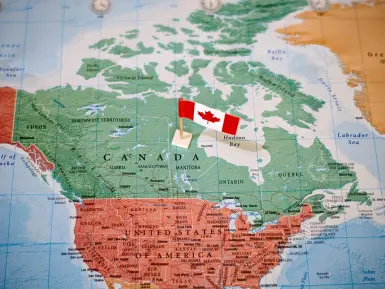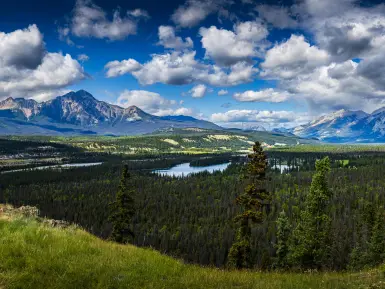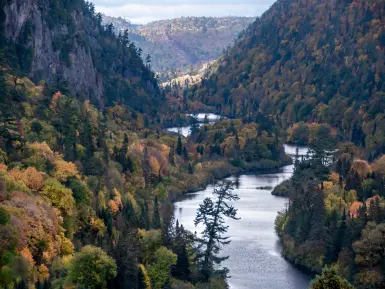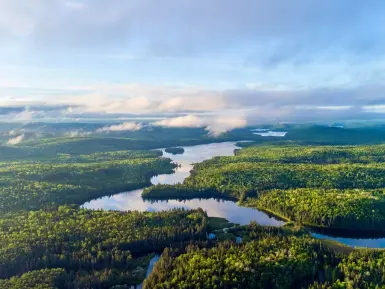In 2008, geologists discovered the oldest rocks on earth. The formations, found on the bedrock of eastern Hudson Bay in Quebec, were determined to be 4.28 billion years old – some 250 million years older than any other known rocks on the planet. Known as the Nuvvuagittuq Greenstone Belt, these rocks are remnants of the Earth’s early crust, created shortly after its formation 4.6 billion years ago. Eight years later, in 2016, scientists revealed in the journal Nature that they had uncovered the world’s oldest pool of water – dating back 2 million years - miles beneath the earth’s surface in Kidd Creek Mine, Ontario.
These revelations prove just how geologically significant Canada’s landscape is – both on a national and global scale. So, it should come as no shock that the country is home to some of the most curious sites – natural and manmade – in the world. From arid Badlands that are a far cry from the stereotypical snowy peaks, to locations that look downright other-worldly, these are some of the most fascinating places that you might be surprised to find on holiday in Canada.
The Athabasca Sand Dunes and Great Sand Hills, Saskatchewan
Jodi at Tourism Saskatchewan describes the impressive scale of the sand dunes in Saskatchewan, which are estimated to be around 8,000 years old. She says:
“The most unique (but very remote) geographical feature of the province, I would argue, is the Athabasca Sand Dunes. They consist of a series of dune fields stretching for about 100 km along the south shore of Lake Athabasca in northwest Saskatchewan. This is the largest active sand surface in Canada and the most northern set of major dune fields in the world. The outstanding scenery is combined with a unique ecosystem, rich in rare and endemic plants which scientists consider an evolutionary puzzle. This area is accessible only by float plane.”
Reaching up to 98 feet tall, these dunes create an unparalleled ecological environment. Endemic plant species flourish, including hair grass, chickweed and even rare species of willow. The geological process of succession, however, means that the flora of the sands is always evolving, with sands engulfing plants. You may even witness the buried remains of former trees emerging from the dunes in particularly harsh winds.

However, you could also visit the Great Sand Hills, also in the province. Corbin Fraser from I Backpack Canada suggests:
“If you're brave enough, bring along a sled, old snowboard, or plastic magic carpet and try your hand at riding the sand dunes. Just be careful not to disturb any of the surrounding nature. It's a delicate ecosystem, but is such an impressive part of Canada.”
Carcross Desert, Yukon

Corbin recommends that anyone planning a Canada car rental trip should also plan to stop off at another location resembling terrain typically found further south - the Carcross Desert. He says:
“This little corner of the Yukon is a perfect example of the stark contrast of landscapes you can find in Canada. Giant mountains loom over a stunning desert, nestled in between lakes, trees, and giant boulders. It's one of the strangest scenes to see mountains meet sand. It's as if the Earth’s crust clawed its way through the sand just to blow your mind. It's a cool place to explore, and only an hour south of Whitehorse.”
If you’re picturing a scene of sprawling sands that threaten to leave all those who venture within lost and perished, think again. The Carcross desert is actually just one square mile in area, making it the world’s smallest desert. Far from arid, the dessert is peppered with lakes, and was indeed once the bed of a Pleistocene glacial lake. Now, however, the area is a popular haunt for hikers and sand boarders who appreciate the mountain backdrop.
Old Quebec City
The quaint, sun-kissed alleyways of Quebec City would not look out of place in Paris or Florence. A distinctly European vibe is evident throughout Quebec province because of its former French occupancy, but this is most visible in the Old City. Here, the ‘old world’ seeps through the cracks of the old stone buildings and cobbled streets, radiates from the vibrant shuttered windows and is punctuated by the ancient Frontenac Castle. No, you’re not wandering the streets of Budapest or Prague – but the strong presence of baroque and Nouvelle France elements could have you believe you’re in French territory – particularly as the language is spoken by many natives.
The fusion of nature and culture is another theme tying together the multicultural streets. Sofie from the blog Wonderful Wanderings comments on one particularly interesting example of architecture that uses a natural resource abundant in Canada:
“If you visit Quebec City in winter, the Hotel de Glace, or Ice Hotel, is a must. Every year it looks different as ice sculptors from all over the world create the most intricate designs as well as ice furniture, an ice bar and an ice reception. The best thing is that you don't even need to stay there to see it all (but you can if you're feeling brave).”
The hotel was completely re-designed for 2017, with the theme being ‘Northern Perspectives’. Intricate sculptures depicting the wildlife and landscapes of the North Pole transported guests to the very top of the world. The hotel is now closed to guests until January 2018, but it is well worth the wait.
Little Manitou Lake, Saskatchewan

Photo credit: Gary Bergen/ Watrous Manitou Marketing Group
Canada has more lakes than the rest of the world combined. In fact, even the province of Saskatchewan has over 100,000 lakes within its borders! From colour-changing waters at Osoyoos, B.C, to the world's largest island lake on earth inside Lake Huron, Ontario, there are plenty of remarkable bodies of water to discover across the country.
However, as Jodi describes, Little Manitou Lake the is unique in itself. She explains, "The lake is fed by underground springs and has a high content of sodium, magnesium and potassium salts, a concentration second only to the Dead Sea itself. This high concentration of minerals means you can float effortlessly.” Nicknamed ‘Canada’s Dead Sea, near Watrous, has been referred to by the Cree in the area as ‘healing waters’ for many centuries due to its unusual qualities.
Pingualuit Crater, northern Quebec
If you’re one of the many people eagerly awaiting the day when space tourism becomes a reality, a trip to the Pingualuit Crater may be in order. The site is within the realms of Earth, but it has an undeniably other-worldly atmosphere about it. Formed by a meteorite hitting the earth almost 1.4 million years ago, the crater encloses a lake created only by precipitation, which spends nine months of the year frozen. Surrounding the lake is a lunar-esque landscape, devoid of inlets or outlets, a unique structure for a natural watering hole.
According to National Geographic, the Pingualuit Crater, which rises from the tundra in northern Quebec, was once mistaken for a kimberlite tube where explorers expected to find diamonds due to the crater’s perfectly-round shape. However, they explain, “those who trek out to Pingualuit today will instead find the Crystal Eye of Nunavik, a deep freshwater lake filled with extraordinarily clear water.” There is no better destination in Canada for a beautiful hike with a thoroughly extra-terrestrial theme.
Mount Thor, Baffin Island
Mount Thor may not be the loftiest of mountains, with its summit sitting at just 1,675 metres of elevation, but there is something very special about this unusual peak. Located in Auyuittuq National Park on Baffin Island, where glacier and polar sea ice meet, rises the rugged granite of Mount Thor. Its foreboding name was given for its wielding of the world’s largest solely vertical drop. All those who seek to climb Mount Thor must not put a foot out of line, because if they do they face 1,250 metres of fall at an average angle of 105 degrees.
This might seem like enough to make anyone in their right mind content to appreciate the mountain from afar. On the contrary, it is this very feature that makes the site a hit with alpine climbers. In 2006, a team of climbers from America set the world record for the longest ever rappel at Mount Thor. For the rest of us mere mortals, camping is allowed, providing perfect access to some utterly stunning hikes.
Flowerpot Island, Ontario
Sometimes we come across landmarks that stop us in our tracks as we attempt to puzzle their origins. Features that are so unusual that it’s difficult for the uninitiated to determine whether they are manmade or just a quirk of nature. In Fathom Five National Marine Park, Georgian Bay, you will find one such feature that has become nothing short of mythic.
Looming over Lake Huron, two gigantic rock sea stacks shoot up from the coast, in curious shapes that resemble flower pots, with trees growing on top. According to Atlas Obscura, an old indigenous legend states that these rocks were created when two young lovers fell in love from the warring tribes of the Ottawa and Chippewa. After concealing their love for some time, they eventually attempted to escape from the shores, paddling toward Flowerpot Island. However, they are said to have been hotly pursued by tribespeople, and ultimately petrified on the beach in the form of these two rocks. These towering stacks add drama to the paradise island, full of fascinating caves, woodland and coast to explore.
Abraham Lake, Banff

Canada is certainly not short of picturesque lakes, but Abraham Lake in Banff has a secret. Visit the lake in summer, with its pristine, smooth waters, and you wouldn’t imagine that the lake takes on a whole new appearance in winter. During the winter freeze, the lake becomes covered in beautiful frozen bubbles, trapped as they rise through the waters.
These frozen bubbles look fantastical, with their jewel-like effect drawing thousands of visitors to the site each year. However, their cause is not so pretty – the bubbles are actually frozen methane. In the warmer months, the methane escapes from the water’s surface in a safe and undetectable process. But hold a match over one of the frozen bubbles as it popped and it would be a very different story – the gas would explode in flames! Providing you exercise caution, however, these bubbles are an enchanting addition to any Alberta hiking holiday.
Tofino, B.C

We won’t blame you if you see a photo of Tofino and assume it’s a tropical island in the middle of the Pacific Ocean. Vibrant green foliage lines the beaches, which are abundant in powder-white sand edging onto cerulean seas. Although it might be on the Pacific, Tofino is, in fact, a coastal region on the west coast of Vancouver Island in British Columbia.
A summertime haven for surfers, bird watchers, whale watchers and all those with a love of the great outdoors, Tofino is famed for its luscious forests and pristine beaches. The climate here isn’t entirely balmy, but the surf is superb. Everyone from first-time novices to long boarders and even professionals will find highly desirable swell here. Sunbathing on the beach, you could certainly convince yourself that you were thousands of miles from the rugged, snowy peaks of the Coastal Mountains just across on the mainland.
Mount Edith Cavell, Jasper

Canada’s mountains are a hotbed of the unexpected – be it record-breaking piste or rare species, the ecology here is unique. However, some of the most charming surprises in Canada’s mountainous regions are found in the details. One example of this is in Jasper, where the flowery foothills you might more readily associate with Japanese or Himalayan mountains are abundant. The craggy summits of Mount Thor seem very far away as you hike through the base camp of Mount Edith Cavell. Eddie Wong from Explore Jasper describes the scene:
“A must see when in Jasper National Park is a mountain called Mt. Edith Cavell, where you can see glacial and alpine flowers in a pristine setting, located only half hour drive from the townsite of Jasper. This year marks the 150th birthday of Canada and the entrance fee is waived for any National Park in Canada.”
The mountain itself is even more interesting for its name. Edith Cavell was a British nurse who served during the First World War. Working in Brussels, she was put in charge of a unit with the aim of helping soldiers trapped behind enemy lines to re-join their units. However, the German army deemed this treason and executed her. The mountain was named as a tribute to Cavell’s bravery, and, at 3,363 metres, the soaring summit certainly fits this honour. However, it is the pretty Alpine meadows, brimming with orange and yellow flowers around a tiny, sapphire-blue meltwater lake, leading onto the stunning Angel Glacier, that make the site so special.
Cape Scott Trail: A journey of Canadian discovery
Sometimes, visiting just one breath-taking site is not enough. If this list has left you wanting to explore more of Canada’s lesser-known landscapes, it might be time to dig out the hiking boots. Cape Scott Trail is one trek that provides the perfect route to experience the diversity of Canadian landscapes. Located on the north-western peninsula of Vancouver Island, Cape Scott Provincial Park offers over 55,000 acres of luscious old growth forests, rugged beaches and wildlife-rich marshland to discover.
Greg from the award-winning blog, Eh Canada Travel, believes that the Cape Scott Trail is underrated, but, for many, the fact that it runs under the radar may be a bonus. He says:
“Access to four remote sandy beaches, shipwrecks, old settler sites, wildlife, a lighthouse, - all with little crowds - is something that is hard to find these days. 24 kilometres of backpacking effort might have something to do with it... One must grunt, groan and grow some bumps and bruises to access this prize, but the reward is epic!”
You might even spot a cougar or a curious black bear along the way!
Image:I Backpack Canada
Latest Articles

How big is Canada?


03/07/2025
A question that many people ask is ‘how big is Canada’? Most people know Canada is big, but just how big is big?

Canada Advocate Q&A: Trish & Cathie's Race Across The World Adventure


01/07/2025
Join us this Canada Day as we celebrate the breathtaking beauty of Canada with Trish & Cathie, the incredible winners of Race Across the World series 3! Discover Canada through the inspiring lens of two adventurers who truly fell in love with its majestic landscapes and vibrant culture.

Sault Ste. Marie Travel Guide: Undiscovered Canada


30/06/2025
Sault Ste. Marie in Canada is one of Ontario’s premier adventure towns, known for its rugged lakes, mountains, and world-class outdoor activities.

Algonquin Park Travel Guide: Iconic Canada


25/06/2025
Algonquin Provincial Park is one of Canada’s most spectacular wilderness regions. The park, which is Ontario’s oldest and largest provincial park, is filled with rocky ridges, fragrant maples and thousands of lakes.











